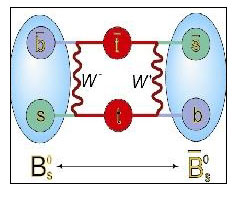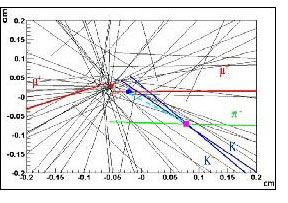TORONTO, April 5, 2006 -- What happened to the antimatter that was created at the birth of the universe? Researchers at Toronto's York University claim to have a clue after reportedly observing the first direct indication of spontaneous transitions of subatomic particles.

How oscillation occurs at the quark level.
Wendy Taylor, York's Canada Research Chair in Experimental Particle Physics, is among a group of a dozen researchers from around the globe who have directly determined, for the first time, the frequency at which a rare particle spontaneously transforms from matter to antimatter and back.
The data, collected by the DZero Experiment at the US Department of Energy's Fermi National Accelerator Laboratory (FermiLab) outside Chicago, proves that a subatomic particle, the Bs meson, oscillates between matter and antimatter in high-speed processes occurring more than 17 trillion times each second, the university said in a statement. The measurement is the culmination of more than five years of research by members of the Bs Mixing group of the DZero collider detector collaboration.

Computer rendition of the decay products of two Bs mesons, one that has oscillated and one that has not.
For decades, scientists have wrestled with the mystery of how our universe of matter survived the Big Bang, which theoretically generated matter and antimatter in equal amounts; they theorize that both should have annihilated into pure energy. The researchers hoped the spontaneous transition of the Bs meson into its own antiparticle could yield clues to this paradox, known as matter-antimatter asymmetry.
"It has been known that the neutral Bs meson (b-antiquark and s-quark) spontaneously transforms into its own antimatter particle (the reverse process also occurs)," the York researchers said. "The current theory of particle physics states that Bs mesons oscillate very quickly. As a result, their oscillations are very difficult to detect, requiring state-of-the-art particle detection technology and large data samples."
In a paper submitted to the journal Physical Review Letters, the DZero scientists identified a preferred oscillation frequency between 17 and 21 times per picosecond (trillionth of a second). The result, a measure of the oscillation, or "mixing," frequency of the particle, was drawn from more than one billion events from the Fermilab particle accelerator.
Almost all Bs mesons turn into anti-mesons in a fraction of a trillionth of a second. By setting the first direct confidence interval of the frequency of the Bs meson's transition to antimatter, the researchers said, their experiment has made an important contribution to improving the understanding of the preponderance of matter over antimatter in the universe.
Professor Taylor said she and her DZero colleagues had hoped the frequency of the oscillations would turn out to be much higher, which would indicate new physical processes that could explain the antimatter mystery. But she said they are "very excited by the result. As soon as we realized our experiment was sensitive enough to set a two-sided bound on the oscillation frequency, we worked around the clock to get the analysis finalized and the paper submitted. It would have been fantastic if we could have said that we have the answer to the matter-antimatter asymmetry problem, but it just means that particle physicists still have lots of important work to do."
For more information, visit: www.yorku.ca